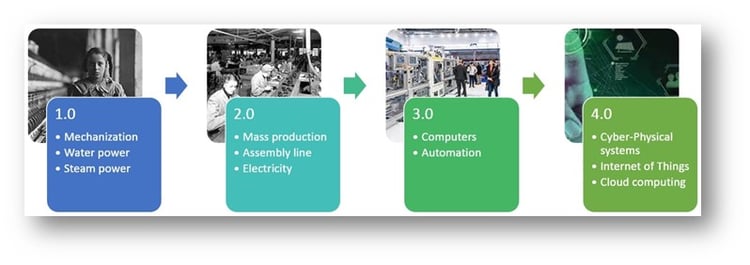
The first Industrial Revolution involved mechanization, employing water and steam power. The second Industrial Revolution moved industry further from artisans and craftsmen, and introduced the huge efficiencies of mass production and the assembly line.
The third Industrial Revolution (Industry 3.0) came with the introduction of computers and automation. This brought another huge wave of efficiencies and reductions in the costs of production.
Now, Industry 4.0 has arrived and the new Industrial Revolution is underway.
Industry 4.0 will encompass cyber-physical systems integrations (think: self-driving cars) and will be predicated on the Internet of Things (IoT) and cloud computing.
Synergies
Certainly, each of the first three Industrial Revolutions (as defined above) brought new efficiencies. Less and less manpower was required to produce and deliver the goods that people wanted and needed. But, not all of the benefits lay in merely "reducing costs." Markets themselves changed, and those who recognized the changes in how markets would change and business would be transacted benefited most from seeing the synergies that would emerge.
I keep on my wall a chart I made to remind me from time to time that the greatest benefits are reaped in business by those who foresee and take advantage of emerging synergies. Here are some examples:
- John D. Rockefeller saw the synergy of the availability of railroad transportation and kerosene (for lamps) to change the way people lighted their homes all across the country. Later, he saw the emergence of the gasoline-powered internal combustion engine as a way to expand his market further.
- Andrew Carnegie saw synergy in the mass production of steel and the need for the expansion of the railroads as his opportunity to grow his market and increase profits.
- Henry Ford leveraged mass production and the assembly line to produce "the car for the common man," thus making his millions.
- Cornelius Vanderbilt took his knowledge of the transportation industry and leveraged the synergies in the growing demand for energy (kerosene and gasoline) and the increasing availability of low-cost steel to create a railroad empire.
What point am I making here?
The point is simply this: If you, your business and your supply chain see Industry 4.0 as a way to merely reduce costs, chances are you will reap some small benefits. But as Industry 4.0 expands across more and more industries and continents, your advantages will continue to shrink into irrelevance.
Beyond Cost-Cutting
If, on the other hand, you have begun to recognize that reducing unit costs is not the same as making more money, then you have an opportunity to leverage the synergies of Industry 4.0's IoT, cloud computing, and collaborative-aiding infrastructure for many more advantages in your supply chain.
After all, leading technologically means little unless management also changes how it thinks. Leading technologically without changing your thinking may lead to merely becoming very efficient at doing the wrong things. (Witness how Henry Ford, who once dominated the auto industry, fell prey to emerging auto makers that brought new thinking to the marketplace. He did not lose his advantage by falling behind technologically, but by failing to change his thinking.)
Reaping the Benefits of Industry 4.0
Our aim is to help companies get their supply chains under control. In order to do this, we begin by helping them begin to see that supply chains are not Newtonian linear systems. Instead, their organizations and their supply chains are Complex Adaptive Systems (CAS) where traditional management approaches no longer deliver the traditionally anticipated benefits.
The traditional rules by which most businesses are still managed to day are more than 60 years old. Many of them had their roots in the first Industrial Revolution, or the second, and have not changed much since. At a minimum, most management concepts are remain rooted in, and unchanged from, Industry 2.0 and 3.0.
Worse! The logic of Industry 2.0 and 3.0 thinking is firmly and irrevocably encoded in nearly every Enterprise Resource Planning (ERP) system employed in business today.
Plainly stated: The rules by which most management thinks and by which most ERP systems operate today are rapidly become unfit to manage the highly volatile and complex events at work in supply chains at this juncture.
This, of course, explains why supply chain management today tends to be a world of constant stress and firefighting.
Demand Driven Planning and Execution
We introduce our clients to demand driven planning and execution methods. These methods are fully-aligned with what is required to produce ongoing improvement (a POOGI) within a CAS. We help them discover the relevant information that can guide the reliable flow of relevant materials all across their supply chain.
This kind of work is ERP-system agnostic. It doesn't make any difference whether you are using an ERP system that cost you $10 million to deploy, or one that required an investment of just $50,000. The fact is, everybody needs the kind of help we can provide if they are going to reap the benefits of Industry 4.0.
Grab Your Copy
Just leave your email address below and we'll send you a copy of 8 Sins of ERP Project Failure.